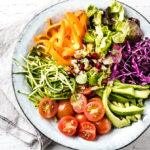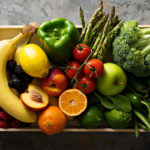Food: Getting Back to Basics
It’s everyone’s favorite time of year: New Year’s! This is a time for a reset, a restart, a refresh from all the iniquities of the previous year. A time when gyms are crowded and salads are all the rave. It’s a time for new habits, new goals, and a NEW YOU. When it comes to making better food choices, don’t fall into the “New Year’s mentality” and go on a diet. Diets are short-lived and broken by 95% of people. Instead, make life changes. Start with smaller, sustainable changes to your dietary habits, ones that are right for you.
As we begin a new Food as Medicine class series for 2019 at the Riordan Clinic, I’ll give you some of my favorite, most impactful dietary changes that you can make. We’ll discuss all of these in more detail the first Wednesday of each month during our class series (see Calendar of Events on page for more details).
 1. Drink Only Water
1. Drink Only Water
Most people are not aware of the excess sugar and calories they consume in the beverages that they drink. The average person consumes 400 calories per day in the beverages. Those calories add up fast! This could easily contribute to 20 pounds of weight gain per year.
Most people consume these beverages out of habit. So, now’s the time to change your habit! Cut back or eliminate calorie-containing drinks. This includes: soda, energy drinks (Gatorade, Powerade, Vitamin Water … etc.), flavored coffee drinks (yes, step away from the Starbucks!), sweet tea, alcoholic beverages, juices (all juices, even ones that are 100% fruit juice), lemonade, and milk.
 2. Eat the Colors of the Rainbow!
2. Eat the Colors of the Rainbow!
Whether we realize it or not, we are influenced by how food looks. We are attracted to food with vibrant color, which is why food companies add artificial food dyes to processed food to make it more appealing to us. The reason we are attracted to color is because foods that are colorful are rich in something called phytonutrients (the prefix phyto means “plant”). These phytonutrients are the rich colors that protect plants from the sun’s UV rays, which means they also have a protective effect in our bodies when we eat them.aaaaaaz
Some examples of these color nutrients are:
Beta carotene – found in orange fruits and vegetables such sweet potatoes, carrots, pumpkin
Lutein – found in green vegetables such as spinach, kale, Swiss chard, zucchini, and Brussel sprouts
Lycopene – found in red fruits and vegetables such as tomatoes, watermelon, guava, grapefruits, papaya, and apricots
Aim to get as many colors in your diet per day as you can. Great ways to do this are with fresh salads and smoothies.
 3. Fuel Yourself with Healthy Fats
3. Fuel Yourself with Healthy Fats
New research (and a re-examination of old research) has shown us that fats are not the foe we once thought them to be. In fact, a study of 48,000 women over the course of 7 years revealed that low-fat diets did not lead to increased weight loss or decreased disease1. The key to dietary fat intake is getting the right types of fat.
Consuming foods containing fats that are high in Omega 6 fatty acids will increase inflammation, while eating those that are high in Omega 3 fatty acids will reduce inflammation. Ideally, we need a balance of both. Eating whole foods will naturally provide a good balance. However, consuming processed foods gives us a higher amount of Omega 6’s in relation to Omega 3’s.
Foods High in Omega 3’s
(eat more of these!)
Wild caught fish (especially salmon)
Grass-fed animal products (meat, butter, eggs, dairy)
Certain nuts and seeds
Foods High in Omega 6’s
(eat fewer of these)
Processed oils like corn, safflower, cottonseed, & soybean
Grain-fed animal products
Processed, pre-packaged foods
 4. Go Organic
4. Go Organic
New research suggests that glyphosate, which is one of the active ingredients in Monsanto’s herbicide Roundup, could be connected with the rising rates of chronic diseases in the United States. More than 1 billion pounds are sprayed in the U.S. alone every year. This herbicide is regularly used on crops that have been genetically modified to be resistant to this chemical. These crops are known as “Roundup ready.” Some of the biggest sources of these genetically modified foods are in processed foods, which include: wheat, soy, corn, and sugar. I don’t think it’s a coincidence that we are seeing skyrocketing rates of allergies and sensitivities to these foods. Glyphosate is particularly damaging to the good bacteria that reside in the gut. This contributes to dysbiosis, or overgrowth of the harmful bacteria, and leaky gut.
If your budget doesn’t allow you to eat all organic, follow the guide put out by the Environmental Working Group called The Dirty Dozen. This list includes the twelve foods with the highest residue of pesticides. If you eat only these twelve foods organic, you will cut out a significant amount of pesticides that you would otherwise be exposed to on a regular basis.
If you are interested in learning more about what foods you can eat to fuel your best health, join us for the Food as Medicine lecture series. The Food as Medicine class has been a staple at the Riordan Clinic for the past 5 years. For 2019 we are expanding this popular lecture into a series that will dive deeper into some of the foundational questions about what food we should eat for our individual needs. The four-part series will be offered multiple times throughout the year. You are welcome to sign up for the whole series or individual lectures. Please visit riordanclinic.org/events for more information about class dates and times.
 5. Cut the Sugar!
5. Cut the Sugar!
It’s no secret that most of us eat more sugar than we should. Whether it’s the occasional ice cream after dinner or Starbucks coffee on a cold day, we all love it. Sugar is a quick source of energy for the body and the brain. We are biologically primed to enjoy the taste of sugar. For our ancestors, this was an advantage because sugar was not as accessible as it is today. For them, sugar was most abundantly available from fruit, which was only available during certain seasons of the year, specifically the end of summer. When they would eat the fruit, they would store up excess energy (as fat), which would sustain them over the winter. In the United States today, refined sugar is added to almost all processed foods. According to the United States Department of Agriculture (USDA), the average American consumes between 150 – 170 pounds of sugar per year, which equals up to a half a pound of sugar per day!
Processed foods in the United States are typically made from cheap ingredients that have been processed and refined. To make these ingredients taste better and to keep taste consistent, food companies add sugar. Typically they are adding a cheap source of sugar called high fructose corn syrup (HFCS) rather than cane sugar.
To decrease the amount of sugar you are consuming, here are a few strategies that I recommend:
- Read food labels! Look at the amount of added sugar in the foods you are consuming. Choose brands that have little or no added sugar and the source of that sugar is cane sugar rather than HFCS.
- Be mindful of the number of servings you are consuming. Ketchup might only have 4 grams of sugar in it, but if you consume 5 servings of it, that’s a whopping 20 grams of sugar!
- Don’t drink your sugar. Beverages are a significant source of added sugar and because we are drinking them versus eating them, we tend not to be as mindful about the amount of sugar.
- Prepare your food from scratch. If you prepare your food at home, you can limit the amount of sugar you use. In most recipes you can cut the sugar in half without noticing a difference in taste.
Howard BV, Manson JE, Stefanick ML, Beresford SA, Frank G. Low-fat dietary pattern and weight change over 7 years: the Women’s Health Initiative Dietary Modification Trial. JAMA. 2006 Jan 4;295(1):39-49.





